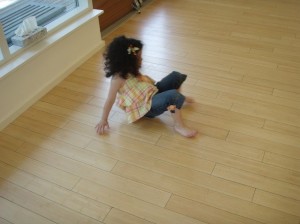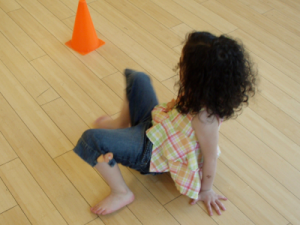Some people say I’m lucky because I never had to spend a lot of money on a “professional wardrobe.” If I had to give one reason why I couldn’t indulge myself in stylish skirts and dresses I’d sum it up in two words: “Crab Walking.” As a “go to” activity for trunk strengthening and improving attention, I often include this activity in home programs. Usually parents need a demonstration to understand what I’m talking about. So down I go, to the floor, during our very grownup meetings; legs splayed as I demonstrate rudimentary “Crab Walking.”
Crab Walking takes a lot of muscle power and the weight bearing helps to activate the filtering system in the brain. That’s why I call it a fabulous “Brain Organizing” activity.
Benefits of Crab Walking:
- Crab Walking requires weight bearing and moving the body against gravity. This is “Heavy Work,” which stimulates the proprioceptor nerves, that in turn, stimulate the nerve cells in the brain that facilitate attention and focus.
- The movement has a bilateral aspect and motor sequencing, both components of motor planning, so the heavy work and motor sequencing help build motor planning ability.
- The heavy work also increases muscle strength. Obviously the trunk gets stronger but the hands and fingers also get a workout for hand strengthening. This in turn helps build fine motor control for writing.
- For children who easily experience sensory overload, this is an excellent way to help them recover from excess energy, anxiety and overstimulation.
- For groups of children, when they begin to get over excited and disorganized, Crab Walking helps channel their energy and refocus them.
Directions:
1. The child sits with the feet flat on the floor and the knees pointing up.
2. Hands go behind the back and push down on the floor to lift the bottom up off the floor.
3. First have the child practice lifting the bottom off the floor. If the child can do this with ease and can maintain the position for 5 to 10 seconds, then begin Crab Walking.
4. It is easier to move backwards. So, have children start by moving backwards.
5. Once Crab Walking backwards is mastered, encourage the child to Crab Walk in a forward direction. Because this is harder, it will take practice. Encourage patience and perseverance.
How to Integrate Crab Walking into the Classroom Routine:
- Classroom transitions: When it is time to change to a new location (e.g circle/group time to table top work).
- Make a “Crab Walk Trail” that students can use when they need to move.
- Incorporate into lessons (e.g. finding puzzle pieces scattered around the classroom).
- Use as a tool to build spatial concepts (e.g. walk around the circle, triangle, square-use tape to mark path).
- To build motor skills (e.g. substitute crab walking while playing soccer, baseball).
- Increase direction following by creating obstacle courses that sequence Crab Walking and other movements.
- Add cones to create a pathway. You can build a sense of direction by telling the child to walk to the right of the cone or left of the cone.


No Pings Yet